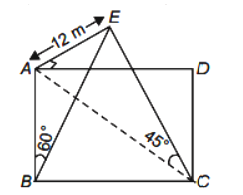Answer
64.8k+ views
Hint:
We use Pythagoras theorem to solve this question. The well-known Pythagorean Theorem states that the square on the hypotenuse of a right triangle equals the sum of the squares on its legs. First we find the values of AB and AC by using simple trigonometric functions. Then by using Pythagoras theorem we find the value of BC and after that we are able to find the area of the field.
Formula Used:
The formula for the Pythagoras theorem is written as $H^{2}=P^{2}+B^{2}$, where
$H^{2}$ is the hypotenuse of the right triangle
and $P$ and $B$ are its other two legs
Complete Step by step Solution:
Let EA be the lamppost at corner A and ABCD be the rectangular field.

Since AE is a vertical pole, all lines in the planes of the rectangular grid are perpendicular to it, i.e., EA is perp. to AB, BC, CD, and DA.
$\therefore \angle \mathrm{EAD}=90^{\circ}$
Given,
$E A=12 \mathrm{~m}$
Join E B, E C, and A C
Also Given that
$\angle \mathrm{EBA}=60^{\circ}, \angle \mathrm{ACE}=45^{\circ} .$
In . $\triangle A B E$,
$\tan 60^{\circ}=\dfrac{A E}{A B}=\dfrac{12}{A B}$
$\Rightarrow \sqrt{3}=\dfrac{12}{A B}$
$\Rightarrow A B=\dfrac{12}{\sqrt{3}}=4 \sqrt{3} \mathrm{~m}$
In $\triangle$ ACE,
$\tan 45^{\circ}=\dfrac{A E}{A C}$
$\Rightarrow \dfrac{12}{A C}=1$
$\Rightarrow A C=12 \mathrm{~m}$
In $\triangle A B C$,
According to the Pythagoras theorem
$\mathrm{BC}=\sqrt{A C^{2}-A B^{2}}$
$=\sqrt{144-48}$
$=\sqrt{96} \mathrm{~m}$
$=4 \sqrt{6} \mathrm{~m}$
Area of the rectangular field $=\mathrm{AB} \times \mathrm{BC}$
$=4 \sqrt{3} \times 4 \sqrt{6}$
$=48 \sqrt{2}$ sq. $\mathrm{m}$
So the correct answer is option A.
Note: The formula for the Pythagoras theorem is written as $H^{2}=P^{2}+B^{2}$, where $H^{2}$ is the hypotenuse of the right triangle and $P$ and $B$ are its other two legs. As a result, the Pythagoras equation can be used to any triangle that has one angle that is exactly 90 degrees to create a Pythagoras triangle.
We use Pythagoras theorem to solve this question. The well-known Pythagorean Theorem states that the square on the hypotenuse of a right triangle equals the sum of the squares on its legs. First we find the values of AB and AC by using simple trigonometric functions. Then by using Pythagoras theorem we find the value of BC and after that we are able to find the area of the field.
Formula Used:
The formula for the Pythagoras theorem is written as $H^{2}=P^{2}+B^{2}$, where
$H^{2}$ is the hypotenuse of the right triangle
and $P$ and $B$ are its other two legs
Complete Step by step Solution:
Let EA be the lamppost at corner A and ABCD be the rectangular field.

Since AE is a vertical pole, all lines in the planes of the rectangular grid are perpendicular to it, i.e., EA is perp. to AB, BC, CD, and DA.
$\therefore \angle \mathrm{EAD}=90^{\circ}$
Given,
$E A=12 \mathrm{~m}$
Join E B, E C, and A C
Also Given that
$\angle \mathrm{EBA}=60^{\circ}, \angle \mathrm{ACE}=45^{\circ} .$
In . $\triangle A B E$,
$\tan 60^{\circ}=\dfrac{A E}{A B}=\dfrac{12}{A B}$
$\Rightarrow \sqrt{3}=\dfrac{12}{A B}$
$\Rightarrow A B=\dfrac{12}{\sqrt{3}}=4 \sqrt{3} \mathrm{~m}$
In $\triangle$ ACE,
$\tan 45^{\circ}=\dfrac{A E}{A C}$
$\Rightarrow \dfrac{12}{A C}=1$
$\Rightarrow A C=12 \mathrm{~m}$
In $\triangle A B C$,
According to the Pythagoras theorem
$\mathrm{BC}=\sqrt{A C^{2}-A B^{2}}$
$=\sqrt{144-48}$
$=\sqrt{96} \mathrm{~m}$
$=4 \sqrt{6} \mathrm{~m}$
Area of the rectangular field $=\mathrm{AB} \times \mathrm{BC}$
$=4 \sqrt{3} \times 4 \sqrt{6}$
$=48 \sqrt{2}$ sq. $\mathrm{m}$
So the correct answer is option A.
Note: The formula for the Pythagoras theorem is written as $H^{2}=P^{2}+B^{2}$, where $H^{2}$ is the hypotenuse of the right triangle and $P$ and $B$ are its other two legs. As a result, the Pythagoras equation can be used to any triangle that has one angle that is exactly 90 degrees to create a Pythagoras triangle.
Recently Updated Pages
Write a composition in approximately 450 500 words class 10 english JEE_Main

Arrange the sentences P Q R between S1 and S5 such class 10 english JEE_Main

What is the common property of the oxides CONO and class 10 chemistry JEE_Main

What happens when dilute hydrochloric acid is added class 10 chemistry JEE_Main

If four points A63B 35C4 2 and Dx3x are given in such class 10 maths JEE_Main

The area of square inscribed in a circle of diameter class 10 maths JEE_Main



